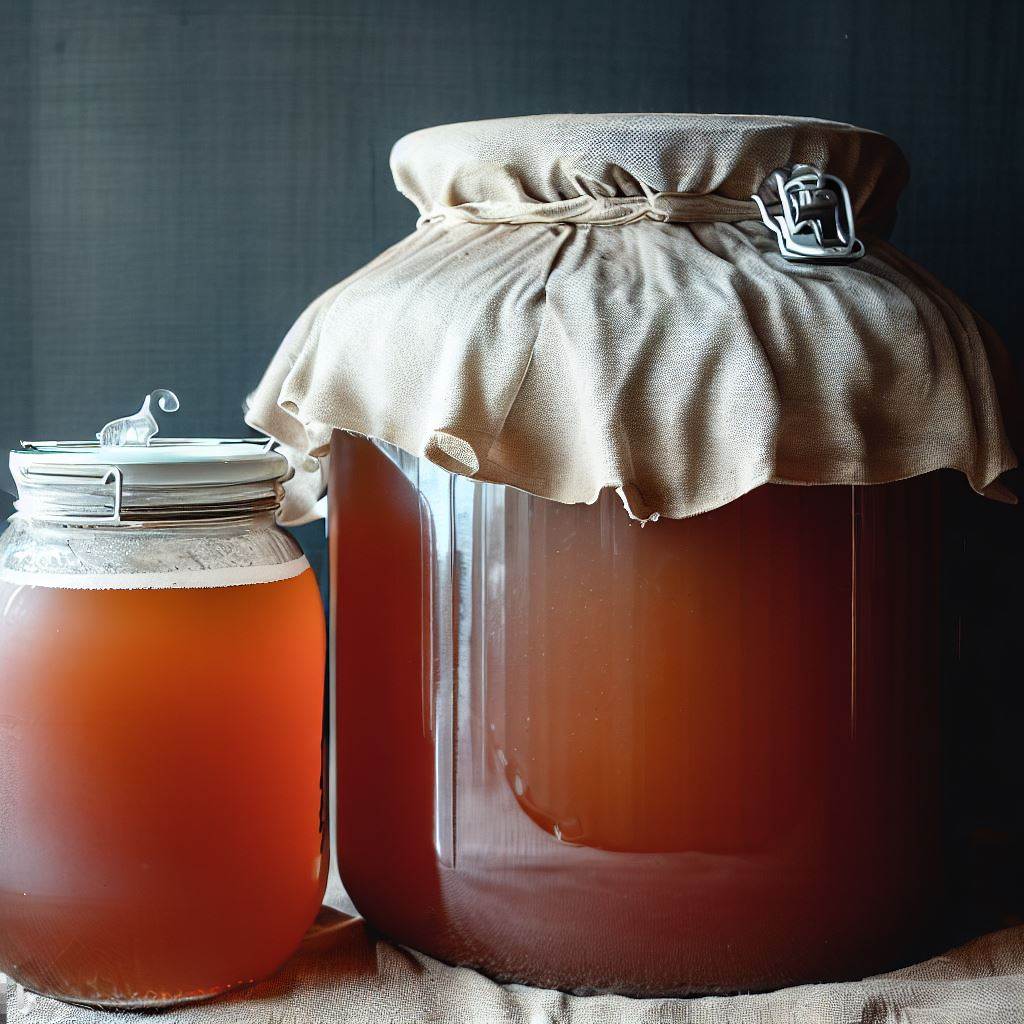Ever been to a hipster café and overheard the word ‘kombucha’ being thrown around more frequently than a frisbee in a dog park? Or maybe you’re a kombucha enthusiast yourself, savoring the tangy, fizzy drink and its touted health benefits. But have you ever wondered what’s behind this beverage’s unique charm? Well, grab your detective hat and a magnifying glass (just kidding, your regular reading glasses would do) as we dive into the heart of kombucha brewing – the S.C.O.B.Y! A living, dynamic part of the brewing process, the SCOBY is instrumental in transforming simple tea into the effervescent elixir we love. Lets dive in!
Unraveling the Kombucha SCOBY: A Deep Dive into the Heart of Kombucha Brewing

What Exactly is a SCOBY?
Remember that time when you accidentally left apple cider in your pantry for too long, and a weird layer formed on top? That’s pretty much the basic idea behind a S.C.O.B.Y. But don’t worry, we’ll elaborate.
S.C.O.B.Y. stands for Symbiotic Culture Of Bacteria and Yeast, a term that pretty much beats any ‘sci-fi’ jargon you might have come across. It’s like the movie Inception, but for microorganisms. This biofilm or ‘mat’ is the mother ship for the bacteria and yeast that convert sweet tea into kombucha, a process otherwise known as fermentation. And while the ugly conglomeration of yeast and bacteria might not win any beauty contests with its pancake-like appearance, it is a kombucha brewer’s prized possession.
Understanding the SCOBY’s Function
The S.C.O.B.Y. plays a role in kombucha brewing as significant as a quarterback in a football game. It is the catalyst that turns sweet tea into the tart, effervescent kombucha we all know and love. And like the good conductor of an orchestra, the SCOBY ensures each player (read: microorganism) hits their notes at the right time.
The yeast in the SCOBY breaks down the sugar in the tea, producing alcohol and carbon dioxide. This is when your taste buds get to party with the fizzy texture. The bacteria then get to work, converting the alcohol into acetic acid, which gives kombucha its distinct tangy taste. So, if you thought the magic of kombucha lay in exotic tea leaves, think again! It’s all thanks to this microbial matinee that is the SCOBY.
Delving into the Anatomy
A S.C.O.B.Y. consists of different layers, each playing a pivotal role in the fermentation process. The top layer is smoother and thicker, forming a barrier to protect the brew from unwanted microbes and contaminants. The layers beneath, home to various yeast and bacteria species, facilitate the complex chemical reactions needed to produce kombucha.
Unraveling the Microbial Magic
At its core, the S.C.O.B.Y. is a host for yeast and bacteria. The yeasts, primarily of the Saccharomyces species, kickstart the process by breaking down sugar into alcohol and carbon dioxide. The bacteria, mostly of the Acetobacter and Gluconacetobacter types, further convert the alcohol into acetic acid, which gives kombucha its distinctive tangy flavor.
How to Nurture Your SCOBY
Just like a beloved pet or a delicate houseplant, your SCOBY requires a bit of TLC. Maintaining a healthy SCOBY is crucial to ensure a successful fermentation process. A few signs of a happy and healthy SCOBY include a cream or tan color, a thickness of about 1/8 to 1/4 inch, and a smooth, uniform surface. However, if you notice any mold, foul smell, or discolored patches, it might be time for SCOBY CPR or replacement.

To keep your SCOBY fit as a fiddle, always ensure to store it in a jar with some kombucha liquid, commonly known as the ‘starter tea’. This helps maintain a suitable pH level and feeds the SCOBY. And remember, SCOBYs are a bit like Goldilocks – they prefer a room temperature environment. Too cold, and the yeast gets sleepy; too hot, and the bacteria might have a meltdown. So, keep it just right!
Creating the ideal environment for your brew
To ensure the health and vitality of your SCOBY, it’s essential to provide it with an optimal brewing environment. Here are some key factors to consider:
- Temperature: Keep the brewing vessel in a warm area, ideally between 70°F and 85°F (21°C and 29°C). Avoid extreme temperature fluctuations.
- Light: Protect the culturefrom direct sunlight, as it can be harmful.
- Airflow: Allow for some airflow while still maintaining a breathable covering to prevent contamination.
- Cleanliness: Maintain a clean brewing environment by regularly sanitizing your equipment and working surfaces.
Feeding and nourishing
SCOBYs thrive on a diet of sweetened tea. As they consume the sugars in the tea, they produce beneficial acids and carbonation. It’s crucial to use the right ratio of tea to sugar to ensure a healthy fermentation process. A common guideline is using one cup of sugar per gallon of tea.
Common issues and troubleshooting tips
While brewing kombucha with a S.C.O.B.Y. , you may encounter some common issues. Here are a few troubleshooting tips to help you overcome potential challenges:
- Mold growth: If you notice mold on your SCOBY or the surface of your brew, discard the entire batch. Mold contamination is rare but can occur, and it’s crucial to start fresh to avoid health risks.
- Sluggish fermentation: If your kombucha is not fermenting at the desired pace, try adjusting the temperature, ensuring proper ventilation, or increasing the sugar content in the tea.
- pH imbalance: Kombucha should have a slightly acidic pH. If your brew is too acidic or too alkaline, adjust the brewing time or experiment with different tea blends.
The Hotel: A Safe Haven for your S.C.O.B.Y.
Over time, your S.C.O.B.Y. will produce baby SCOBYs. These can be stored in a SCOBY hotel, a simple glass jar filled with sweetened tea and mature SCOBYs. Maintaining a SCOBY hotel ensures you always have a backup and can share the kombucha love with friends.
Harvesting Your SCOBY
Harvesting your s.c.o.b.y. should be a gentle process. When your kombucha has fermented to your taste, carefully remove the SCOBY using clean hands or utensils. You can then store it in your SCOBY hotel, or use it immediately to start a new batch.
The Endless Possibilities
The SCOBY isn’t just for brewing kombucha. It can also be used in numerous culinary applications, from vegan leather to SCOBY fruit snacks. And, of course, it can be composted, ensuring a zero-waste brewing process.
Final Thoughts
Unassuming yet indispensable, the SCOBY forms the backbone of every successful kombucha brewing adventure. The world of kombucha brewing can be quite an adventure, with the SCOBY being your ever-dependable sidekick. It’s a weird, slimy, yet fascinating creation of nature that is integral to the magic of kombucha. So, the next time you’re sipping on your favorite brand of kombucha (or homemade), remember to give a silent thanks to the mighty SCOBY, the unsung hero behind your delightful beverage!By understanding its nature, composition, and needs, you can not only produce delicious kombucha but also delve into the fascinating world of home fermentation. Happy Brewing y’all!
Frequently Asked Questions

Can I make my own SCOBY at home?
Absolutely! All you need is sweet tea, a bottle of store-bought raw, unflavored kombucha, and some patience. Add the kombucha to the sweet tea, cover the jar with a cloth, secure it with a rubber band, and let it sit for 2-4 weeks. Voila! Your homegrown SCOBY is ready.
How long does a SCOBY last?
With proper care, a SCOBY can last a long time. It’s a living organism that continuously grows and reproduces. In fact, after each brew, a new layer or ‘baby’ SCOBY forms on top of the ‘mother’ SCOBY. We generally advise to use a SCOBY about 6-12 times but if you continually trim it you can use it almost indefinately as long as it is still healthy and has no mold.
Is it safe to consume the SCOBY?
While the SCOBY is not typically consumed, it is safe to eat. Some people even incorporate SCOBYs into recipes for a source of dietary fiber and probiotics. However, it’s generally more enjoyed in its liquid form – the kombucha!
What is the difference between a SCOBY and a mother culture?
A SCOBY and a mother culture are often used interchangeably, referring to the same kombucha culture. The mother culture is the original, mature SCOBY that forms during the fermentation process, while SCOBY refers to the collective culture that includes both the mother culture and any new layers that develop.
Is it normal for my SCOBY to have a strong smell?
SCOBYs have a distinct aroma that can vary from mildly vinegary to slightly funky or sour. This odor is entirely normal and indicates the presence of healthy fermentation. However, if your SCOBY develops an overpowering or unpleasant smell, it could be a sign of contamination or spoilage, and it’s best to discard it and start fresh.
Can I use a SCOBY from one type of tea to ferment another type of tea?
While it’s possible to use a SCOBY from one type of tea to ferment another type of tea, it’s generally recommended to stick with the original tea type. SCOBYs adapt and thrive in the environment they’re accustomed to, and changing the tea type may affect the balance of bacteria and yeast. However, if you decide to experiment, monitor the fermentation process closely for any unusual signs or flavors.
Thanks for reading our Greek Mountain Kombucha Blog Post on “What is a SCOBY?” for Kombucha brewing. Read on some additional articles!







